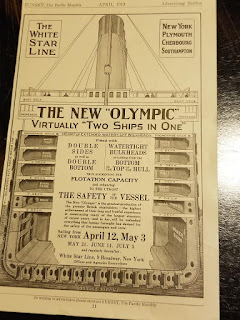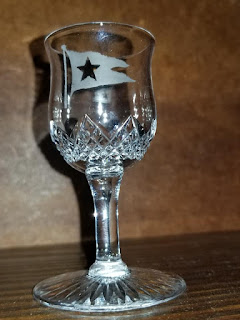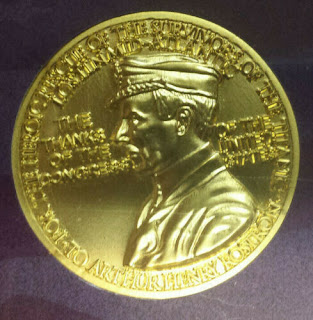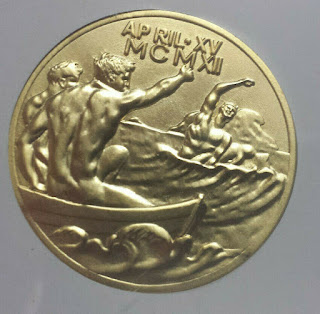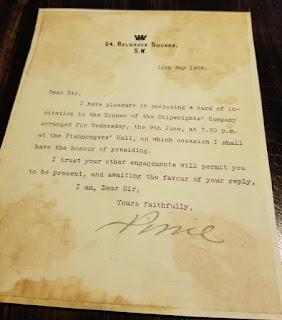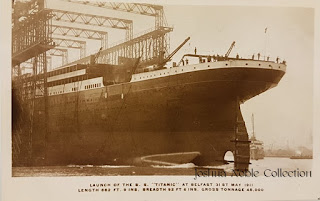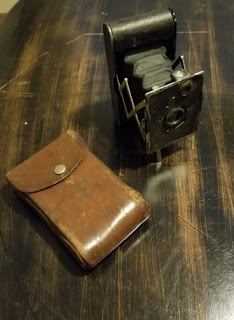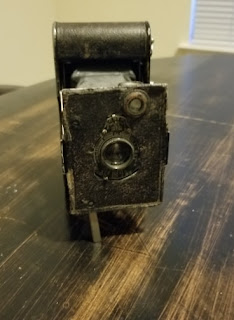After the Titanic sank, changes were made to the designs of upcoming ships to make them safer including more lifeboats. This advertisement from 1913 depicts the changes made to the Titanic's older twin sister ship, Olympic. She was taken out of service and more lifeboats were added along with a thicker hull and higher bulkheads.
Titanic Legacy: The Online Museum
Saturday, April 13, 2019
Thursday, March 28, 2019
Captain Rostron Medal
When Captain Rostron rescued the Titanic survivors the morning after the disaster and brought them to New York, he was hailed as a hero. He was given many awards and much praise as a result of his actions. Among the awards he received as a Congressional Gold Medal in 1913. This is a replica of the one awards to him by Congress.
Thomas Andrews
Thomas Andrews (1873-1912) started his career as an apprentice at Harland & Wolff at the age of 16. He came from a family of politicians and businessmen including his great-uncle, Lord Pirrie, who was the Managing Director of Harland & Wolff. He worked his way up and became chief designer. In 1908, Thomas Andrews married Helen "Nellie" Barbour. They had one daughter born in 1910. Thomas Andrews and a group of men who built the Olympic and Titanic called the Guarantee Group sailed on the maiden voyages to make notes of what was going on and how they can improve the next ship. Andrews was on the Titanic for her maiden and final voyage. After the iceberg was struck, Andrews was called on by Captain Smith to investigate the damage. Andrews was the one who calculated the damage and that she would sink. Andrews was seen encouraging people to put on their life jackets and get into the lifeboats and throwing deck chairs overboard for those in the water. He was last seen on the Bridge with Captain Smith. His body was never recovered.
This is a telegram that was sent to Thomas and Nellie from their friend Jim on the day of their wedding wishing them congratulations and telling Nellie he sent keys to them.
Lord Pirrie
Lord William Pirrie was the Managing Director of Harland & Wolff and according to legend was one of the people who had the idea for the Olympic Class. He not only had a great professional shipbuilding career, he also had a political one. He served as Lord Mayor of Belfast and was active in the politics of the time. Harland & Wolff at the time employed a great many people in Belfast. His brother in law was Alexander Carlisle and his great-nephew was Thomas Andrews, both of whom designed the Titanic. In addition, he was a good friend of Captain EJ Smith. When he died in 1924 near Cuba while he was on a business trip to South America, the Titanic's twin sister ship Olympic brought his body back home.
This letter has not one, but two connections. The stationary from 24 Belgrave Square is from Lord Pirrie's home in London where the idea for the Olympic Class Liners was supposedly discussed. The letter from Pirrie invites Mr. Richard May who was a Titanic cross channel passenger to a dinner party. It was in Richard May's scrapbook along with other Olympic and Titanic memorabilia.
Titanic Launch
At 12:15 AM on May 31, 1911, the RMS Titanic's hull moved for the first time. No champagne was broken on the bow as many have done. Instead, rockets were fired to alert ships in the River Lagan and when the signal was given, she moved down the slipway with 22 tons of soap to ease her movement down into the sea.
These pre-sinking photographic postcards show the Titanic just before and during her launch. Both are very rare and hard to find.
Saturday, March 23, 2019
Through The Lenses of History
The things that help us know and envision what it was like to be on the Titanic are primarily photographs and survivor accounts. And the main photographers that documented the Titanic's short life were Robert Welch, Kate Odell, and Father Francis Browne. Below is the same type of camera Father Browne used to take his photographs of the interiors and exteriors during his short time on board. When he disembarked at Queenstown, he brought with him some of the last photographs of the ship and many of her the people on board.
To view his photographs, this website has many of the photographs he took of the Titanic.
Subscribe to:
Posts (Atom)
